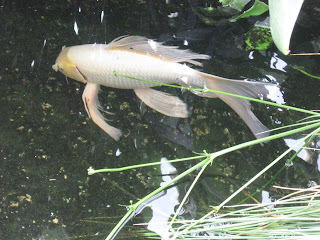 Of the all the Koi, the Butterfly Koi fish is perhaps the most beautiful. With it's long, flowing fins and magnificent colors it is both graceful and elegant. These fish have dorsal, ventral, pectoral and caudal fins that are long, flowing and almost featherlike in appearance.
Of the all the Koi, the Butterfly Koi fish is perhaps the most beautiful. With it's long, flowing fins and magnificent colors it is both graceful and elegant. These fish have dorsal, ventral, pectoral and caudal fins that are long, flowing and almost featherlike in appearance.This distinctive breed is described by the Japanese as "living jewels" and by the Chinese as "swimming flowers".
Besides being so beautiful, with their long flowing fins, this particular fish has been bred to be extemely hardy. Even hardier than the standard fin, they are able to withstand colder temperatures better as well. This is based on hybrid vigor or heterosis. The Butterfly Koi and Standard Koi can interbreed easily.
The breeding program of this elegant fish began in the United States in the early 1980s. A gentleman named Wyatt Lefever had obtained some beautiful and unusual long-finned hybrid Asian carp. He began a breeding program. He crossed the hybrid Asian Koi with metallic colored Koi resulting in the beautiful Butterfly Koi fish. These fish have been available in the United States for the past seven or eight years.
These beautiful fish are not the result of breeding goldfish with Koi as many people believe. While Koi and goldfish are closely related their offspring are very unattractive (at least compared to their colorful Koi and goldfish parents). They more resemble wild carp and have very little color.
The Butterfly derivation of the breed first originated in Japan in the mid 20th century due to an effort by the Japanese to increase the hardiness of the breed as a whole. The Japanese breeders bred Indonesian long-finned river carp with traditional Koi. The fish from this breeding, that later became known as the Butterfly Koi fish had longer fins, long barbells and pom pom nostrils. They was also hardier than the standard Koi.
The breed was known in Japan as "onagaoi" or "hire naga koi", which translated into English means "long tailed Koi". It was Randy Lefever, the son of Wyatt Lefever, who is credited with saying that they looked like butterflies. The Japanese sometimes refer to them as Dragon Koi.
Many people breed them for competition. Butterfly Koi fish can't be judged using the judging methods for standard Koi.
A couple of reasons that they can't be judged according the same criteria are conformation and the relation of the fin to the body.
The traditional ideal shape of the standard Koi has been set to be generously oval. In Butterfly Koi the shape is naturally more slender. This difference in the fish's conformation is amplified by the fact that judging is done by viewing the fish from above.
In "Nishikigoi" judging ("nishikigoi" means domesticated carp) the ratio of fin to body is an important scoring criteria. This elegant breed of Koi fish has a ratio that exceeds the standard by 500-1000%.
While body shape and fin length are different for both breeds, the judging criteria for color and pattern are the same.
Even though they have some different attributes than standard Koi you may find that you have an even greater appreciation for the beautiful Butterfly Koi fish.
No comments:
Post a Comment